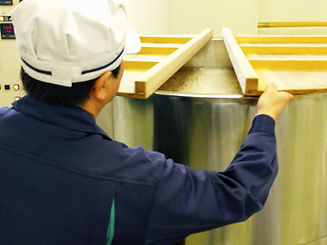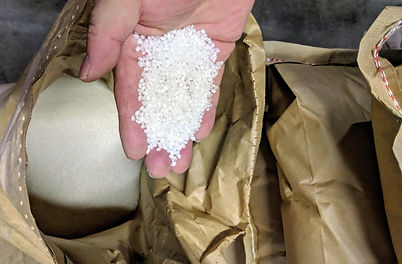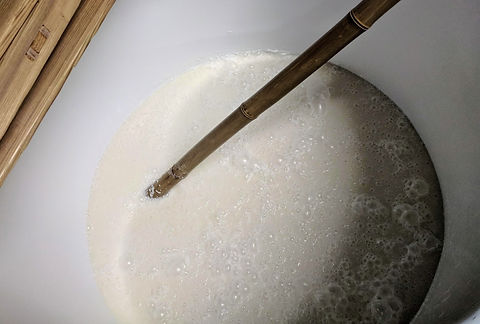
THE MAKING OF SAKÉ

Like wine and beer, Japanese saké is an alcohol obtained by fermentation. But, in the case of saké, the process is longer and more complicated. It is this complexity that allows the Toji (master brewer) to develop nihonshu with unique aromas and flavours that can be enjoyed both cold and hot.
For wine, grape juice already contains the simple sugars that the yeasts will convert into alcohol. This is called simple fermentation.

To make alcohol from cereals (or potatoes), one must first transform their starch into simple fermentable sugars so that the yeasts can produce alcohol. For beer, barley is malted (sprouting by steeping) and, then, when the malt is heated in water, its enzymes work by transforming complex sugars (starch) into fermentable simple sugars (glucose, dextrose and maltose); it is saccharification. The yeast, in a second step, will metamorphose these sugars into alcohol. This is called successive multiple fermentation; saccharification followed by fermentation.

In the unique case of nihonshu, we proceed with a parallel multiple fermentation; the saccharification of the rice starch and the alcoholification of the simple sugars obtained take place at the same time in the same tank. This is because Toji uses koji (a type of mould) to saccharify and dissolve the starch in rice. And the yeast proliferates and acts at the same time as the koji creates the fermentable sugars.

The stages of
saké making

Rice cultivation:
Rice varieties grown expressly for saké such as Gohyakumangoku, Koshitanrei, Koshiibuki or Miyamanishiki have grains with lower protein content and larger starch core with deeper grooves.
These varieties are called Sakamai 酒米.
Polishing:
The rice is carefully polished to rid it of its husk of bran and much of the endosperm. The grain thus loses proteins, lipids and iron which would otherwise interfere with the solubilization, saccharification of the rice and the final taste. We keep the starch core named Shimpaku 心 白. Rice is reduced by at least 25% of its weight. Some brewers only preserve 10% of the grain!
The more polished the grain, the more the saké will have a strong aroma, delicate flavour and higher price.

Washing and soaking:
After polishing, the rice should recover its moisture. It is first washed to get rid of the polishing residue. Then it is soaked for between one and three hours to hydrate it enough to make it penetrable by the Koji, but not too much to make it too soft and difficult to handle; also, the more it soaks, the more it loses certain minerals such as potassium and magnesium that nourish the Koji. For some varieties of rice like Omachi, or rice with a high-polishing rate, the soaking is done manually and can last between 5 and 15 minutes.
Steaming:
The rice is steamed for 30 to 60 minutes. The rice is then cooled and divided; while a portion is kept for the brew, a small amount will be used to prepare the Koji.
Steaming has two functions. First, it pasteurizes the grains, the Koji and the yeasts will be able to grow there all the more quickly as there will be no bacteriological competitors. Then, the cooking gelatinizes the starch; which makes it more vulnerable to the enzymatic action of Koji spores.


Koji (麹):
In a room called Kojimuro (麹室) where the air is hot (35° or more) and very humid, cooked and cooled rice is sprinkled with spores of Koji (麹), a fungus known as Aspergillus Oryzae and mainly used to break down starch into fermentable sugar. This is because the Koji exudes saccharification enzymes like alpha amylase and glucoamylase which break down the long molecular chains of starch into simpler, fermentable sugar. The Koji is allowed to grow between 40 and 48 hours.
The term Koji refers to the fungus; the inoculated grain is called Komekoji (米麹). About half of the Komekoji will be used to create the mother culture, the Shubo (酒母).
The starter or the Shubo (酒母):
Polished and steamed rice, water and yeast are added to the Koji to form the starter, which will serve to start and catalyze the fermentation of the main wort.


Fermentation of the main wort, Moromi:
In a large vat, steamed rice, water and Kakekoji are added to the Shubo (the starter). The addition of these ingredients is done in three stages spread over several days; at each stage, we double the quantity of ingredients already added. At the beginning, it is as if we were doubling the mother culture. After a good proliferation of yeasts, on two occasions, the volume of the wort is increased. Thus, the yeast concentration always remains high preventing contamination of the brew (Moromi) by wild yeasts or other unwanted microorganisms.
Pressing and Filtration:
The Moromi is passed through a press in which the liquid is separated from the dregs. Then it is filtered.
Pasteurization:
Saké is normally pasteurized at 65 ° to kill yeast and neutralize enzymes that could alter flavours.
Maturation:
The saké rests between 30 and 90 days in a maturation tank. Some are even aged for a few years.
After this step, there is normally a second pasteurization and packaging for sale.
If for wine the terroir can be important, for saké, the environment of the factory plays a decisive role.
You will understand that in the first place, the quality of the water source is crucial. And since the brewing is done in open tanks, the temperature and the air quality add to the variables which generate a great diversity among the sakés.
One can understand that the purity of the water source is crucial. And since the brewing is done in open vats, temperature and air quality add to the variables that create great diversity among sakes.
For saké, even though the ingredient list is limited to water, rice, koji and yeast, the complexity and length of the process allows the Toji to compose unique aromas and flavours. Although the taste and aromatic potential of the rice used are certainly expressed in the saké, certain flavours and aromas are more determined by the purity of the water, by the choice of koji and yeast, by the know-how of Toji and by the thoroughness of the kurabito (artisans of the saké factory).
